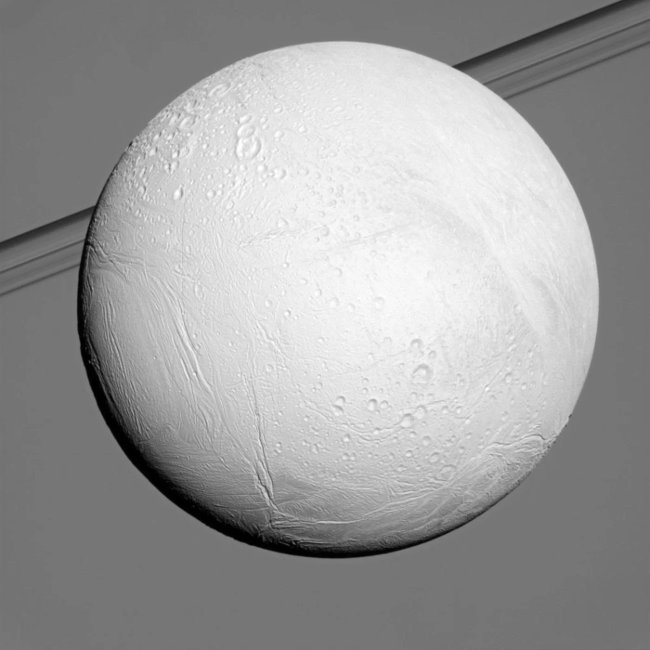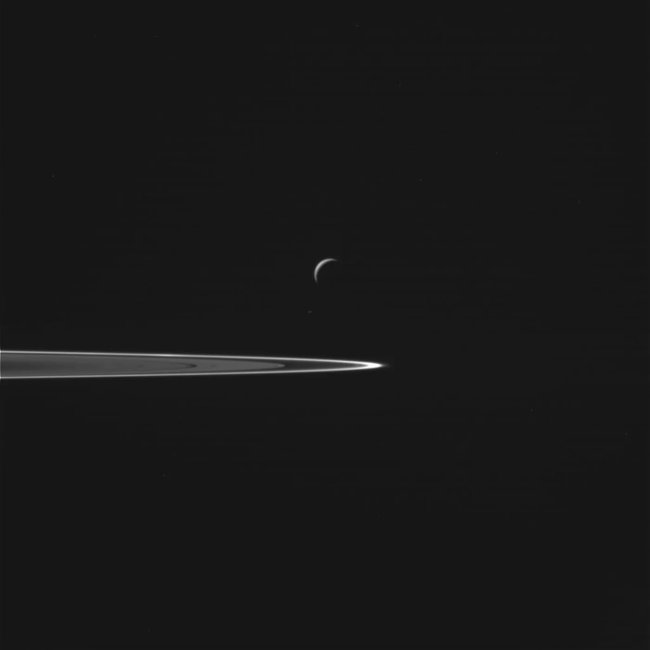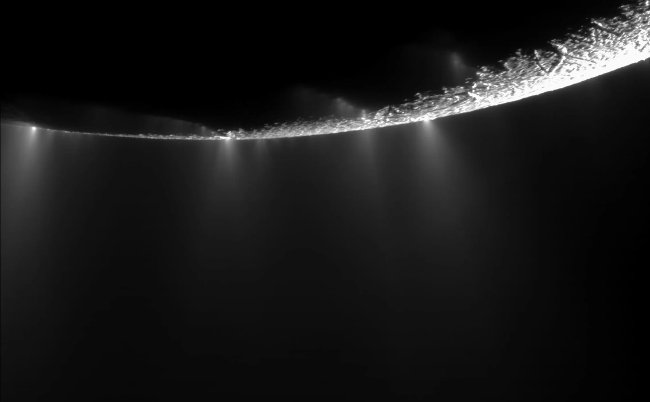50 images of Saturn's Enceladus moon - where life can exist (Part 1)
If it is determined that Saturn's moon Enceladus exists, this will be one of the greatest discoveries in human history.
Right in the solar system, it's not only our planet Earth that has water. The barren Mars has been proven by many studies that it once existed and now, the upper planet has a giant ocean. Scientists at NASA call them " Ocean World - Ocean World" - Earth-based planetary systems, the planet has a thick ice covering over the vast ocean below.
Join the Network Administrator to admire 50 images of Saturn's Enceladus moon - where life can exist below!
Saturn's moon Enceladus

Photo source: NASA / JPL-Caltech
Saturn's moon Enceladus was observed by NASA's Cassini spacecraft, studying Saturn and its surrounding moons since 2004.
Saturn's moon Enceladus and Saturn's belt

Photo source: NASA / JPL-Caltech / Space Science Institute
Saturn's Enceladus satellite was collected by NASA's Cassini spacecraft via a flight near the icy Moon on October 28, 2015.
Water spray on the moon Enceladus Saturn

Photo source: NASA / JPL / SSI
More than 100 sprinklers, organic matter and other substances enter space from the southernmost region of the Saturn satellite Enceladus.
Moon Enceladus

Photo source: NASA / JPL / Space Science Institute
The Cassini space probe has studied Saturn and its moons since entering orbit in 2004. This image was taken on October 5, 2008, a beautiful mosaic of ant activity. created on Enceladus after a Cassini flight.
Steam flow at moon Enceladus

Photo source: NASA / JPL-Caltech / Space Science Institute
Images of Saturn's moon Enceladus, collected by NASA's Cassini spacecraft during a close flight of the icy Moon on October 28, 2015.
Hydrothermal compartment

Photo source: NASA / JPL-Caltech
Graphic images simulating the process of the interaction between Enceladus satellite and hot ocean rock, this process produces a large amount of hydrogen gas causing redundancy.
The Cassini spacecraft flew through the steam stream on Enceladus' surface

Photo source: NASA / JPL-Caltech
This illustration shows NASA's Cassini spacecraft flying through the steam stream on the surface of Saturn Enceladus in 2015.
The surface of the moon Enceladus Saturn

Photo source: NASA / JPL-Caltech / Space Science Institute
Close-up image of the surface of Saturn's Enceladus moon collected by NASA's Cassini spacecraft during a flight to the icy Moon on October 28, 2015.
Polar region south of the moon Enceladus

Photo source: NASA / JPL-Caltech / Space Science Institute
The polar region south of Saturn satellite Enceladus has been explored the deepest by NASA's Cassini spacecraft through the icy steam of the moon. Images are published on October 30, 2015.
Cassini images taken at the northern pole of Enceladus

Photo source: NASA / JPL-Caltech / Space Science Institute
NASA's Cassini spacecraft captured this scene at the northern pole of the Saturn Enceladus Saturn in flight on October 14, 2015.
Cracks near the moon Enceladus

Photo source: NASA / JPL-Caltech / Space Science Institute
NASA's Cassini spacecraft captured this image near the North Pole of the icy Saturn Enceladus satellites on October 14, 2015. Thin cracks undergo concave pits - part of a network of cracks surrounding satellite.
Saturn's Enceladus Moon on October 28, 2015

Photo source: NASA / JPL-Caltech / Space Science Institute
The image of the planet Earth's Enceladus satellite was collected by NASA's Cassini spacecraft during a close flight of the icy Moon on October 28, 2015.
Many large dents on the surface of Enceladus satellite in the far North

Photo source: NASA / JPL-Caltech / Space Science Institute
This image was taken on October 14, 2015 by NASA's Cassini spacecraft, showing large dense pits around the Saturn satellite of the Enceladus Saturn.
Cassini spacecraft on satellite Enceladus

Photo source: NASA / JPL-Caltech
Illustration of NASA Cassini spacecraft on Saturn satellite Enceladus. The Cassini spacecraft is making the most recent flight on Enceladus satellite in 2015.
Structure of satellite Enceladus

Photo source: NASA / JPL-Caltech / SSI
A slight fluctuation in Saturn's moon Enceladus reveals that the planet contains an ocean world beneath its icy crust. Some of these oceans " emerge " from the south pole.
Photo taken in the south of Enceladus satellite

Photo source: NASA / JPL-Caltech / Space Science Institute
Recent images of Saturn's moon Enceladus are captured by Cassini spacecraft in the south of Enceladus, containing giant oceans beneath the surface layer, scientists have recently confirmed.
Enceladus - Saturn's snowball

Photo source: NASA / JPL-Caltech / Space Science Institute
Saturn's moon Enceladus is covered with a layer of snow and ice, which looks like a snow globe - an image taken from NASA's Cassini spacecraft posted on March 10, 2012. It shows the face of Enceladus satellite. The North of Enceladus satellite turns up and turns 6 degrees to the left.
When cold: Saturn's Enceladus satellite

Photo source: NASA / JPL-Caltech / Space Science Institute
NASA's Cassini spacecraft captured the satellite image of Enceladus, which was only partially illuminated, the icy moon of Saturn, which was published on December 23, 2013. The image was taken on July 7. 4 2013 showed that the surface of Enceladus satellite ( 313 miles or more 504km ) returned in the orbit of the Saturn moon.
Steam stream 1024 on Enceladus satellite

Photo source: NASA / JPL-Caltech / Space Science Institute
The reflected light helps the Cassini spacecraft capture the steam and surface of Enceladus satellite, giving this wonderful image.
Unprocessed prototype image of Enceladus satellite

Photo source: NASA / JPL-Caltech / Space Science Institute
The image of the untreated prototype of Enceladus was taken by NASA's Cassini spacecraft on May 2, 2012. The camera is located 385,919 km (239,799 miles ) from Enceladus satellite.
"Crescent" Enceladus

Photo source: NASA / JPL-Caltech / Space Science Institute
This unprocessed prototype image was taken by NASA's Cassini spacecraft on May 1, 2012. The camera is located about 419,142 km ( 260,443 miles ) from Enceladus satellite.
Saturn's moon Enceladus was captured by the Cassini spacecraft

Photo source: NASA / JPL-Caltech / Space Science Institute
This image shows the hemisphere of Saturn's Enceladus satellite. The image was taken on November 6, 2011 by NASA's Cassini spacecraft, while exploring at a distance of 109,000 km ( 67,700 miles ) from the icy moon.
Close up of grooves on the moon's surface Enceladus

Photo source: NASA / JPL-Caltech / Space Science Institute
This image shows the grooves in the southern part of Saturn's Enceladus satellite. This image was created using synthetic-aperture radar (SAR ) data collected by NASA's Cassini spacecraft on November 6, 2011. The radar image is overlaid on one light blue layer through the previously visible light image.
Moon Enceladus and Saturn belt

Photo source: NASA / JPL-Caltech / Space Science Institute
NASA's Cassini spacecraft captured Enceladus's untreated prototype on November 6, 2011 and on Earth received on November 7, 2011. The camera is located approximately 144,790 from Enceladus satellite. km ( 67,100 miles ) and the image was taken using CL1 And CL2 filter.
Satellite Enceladus - November 6, 2011

Photo source: NASA / JPL-Caltech / Space Science Institute
This is the untreated prototype of the moon Enceladus on Saturn taken by NASA's Cassini spacecraft on November 6, 2011 and received on Earth on November 7, 2011. Camera This is about 108,044 km ( 67,100 miles ) from Enceladus satellite. Images were taken using CL1 and CL2 filters.
continue.
- 50 images of Saturn's Enceladus moon - where life may exist (Part 2)
- Life may exist on Saturn's moon
- It is possible that life has appeared on the moon Enceladus, which we do not know
- An alien moon that is 'coming of age' produces life
- NASA has revealed evidence that extraterrestrial life exists in the Solar System
- NASA announced a place that could exist in the solar system
- Detecting sea water on Moon Enceladus of Saturn
- Curious with the giant Y on the Moon Enceladus
- There may be an ocean hidden deep beneath the crust of the moon Enceladus
- Add convincing evidence of life on Saturn moon
- The giant ocean on Saturn's moon may contain life
- Cassini flies close to the moon of Saturn
 The 11 most unique public toilets in the world
The 11 most unique public toilets in the world Explore the ghost town in Namibia
Explore the ghost town in Namibia Rare historical moments are 'colored', giving us a clearer view of the past
Rare historical moments are 'colored', giving us a clearer view of the past The world famous ghost ship
The world famous ghost ship